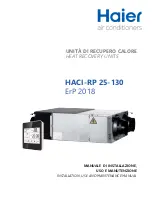
7
Insignia NS-H3005 Home Theater System
www.insignia-products.com
CD playback
Each time you press SOUND, the audio CD
sound mode is changed in the following order:
•
Bypass
•
PRO Logic
•
Music
•
Matrix
•
3D Surround
Connecting your home
theater system
Connecting antenna or cable TV to the
home theater system
To connect the antenna or cable TV to your
home theater system:
1 Disconnect the antenna or cable TV leads
from the back of your television.
2 Identify the type of cable from your antenna
or cable TV. If it is a round cable as
illustrated, it is a 75 ohm coaxial antenna
cable. This cable connects directly to the jack
marked ANTENNA/CABLE IN on your home
theater system.
Connecting without a cable box
If your cable wire is connected to your television
without a converter or descrambler box, unscrew
the wire from your television and attach it to the
ANTENNA/CABLE IN jack on the home theater
system. Use the supplied round coaxial cable to
connect between the home theater system’s
ANTENNA/CABLE OUT jack and the 75 ohm
antenna input jack on the television. With this
connection, you can receive all midband, super
band, and hyperband channels.
Connecting with a cable box
If a cable converter box is required in your cable
system, follow these instructions. This cable
hookup permits both television and home
theater system operation.
To view or record CATV channels:
1 Tune the television to the home theater
system output channel (CH 3 or 4).
2 Set the home theater system channel
selector to the output channel of the cable
converter box by using the
or
on your
home theater system. (Example: CH3)
3 Select the channel to view or record at the
cable converter box.
Note
•
The player memorizes the last mode setting for each source
individually.
•
You can identify the encoding format of program software
by looking at its packaging.
Dolby Digital discs are labeled with the logo
.
Dolby Surround encoded programs are labeled with the
logo
.
DTS Digital Surround discs are marked with DTS.
•
When you play sound tracks with 96kHz sampling
frequency, the output signals are converted to 48kHz
sampling frequency.
Note
•
Depending on your television and other equipment you
want to connect, there are various ways to connect the
home theater system. Use connections described on
page 7 through page 9.
•
Refer to your television, VCR, and Stereo System manuals
to make the best connections.
•
Make sure that the home theater system is connected
directly to the television. Tune the television to the correct
video input channel.
•
Do not connect your home theater system through another
VCR. The DVD image could be distorted by the copy
protection system.
Note
If your antenna lead wire is a flat type antenna cable, connect it
to an antenna adapter (300-ohm to 75-ohm) (not supplied) and
plug the adapter onto the ANTENNA/CABLE IN jack. The
adapter does not screw onto the jack, it just plugs over it.
Note
During DVD or VCR playback, the home theater system is
designed so that sound is heard only from the home theater
system’s five speakers and subwoofer. No sound output is
provided to the television if it is connected to the MONITOR
OUT jack on the home theater system with optional cables.
Note
•
With this connection, you cannot record one program while
viewing another.
•
If you are using a cable box to tune channels, it is not
necessary to complete Auto Channel Programming as
indicated on page 12.
Antenna
Antenna
Cable TV
wall jack
Back of home theater system
Flat Wire
(300 ohm)
300/75
ohm
adapter
(not
supplied)










































